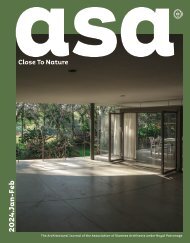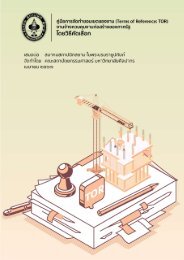ASA JOURNAL 11/2023
You also want an ePaper? Increase the reach of your titles
YUMPU automatically turns print PDFs into web optimized ePapers that Google loves.
138<br />
Revisit<br />
THE BANGKOK SCHOOL FOR THE BLIND<br />
139<br />
05<br />
บรรยากาศภายใน<br />
ห้องเรียนโรงเรียน<br />
สอนคนบอด<br />
ถ่ายเมื่อ พ.ศ. 2566<br />
เครดิตภาพ:<br />
โดยผู้เขียน<br />
06<br />
ผังพื้นโรงเรียน<br />
สอนคนตาบอด<br />
เครดิตภาพ:<br />
Taylor, Brian Brace<br />
and John Hoskin,<br />
Sumet Jumsai,<br />
Bangkok:Asia Books,<br />
1996., p.<strong>11</strong>4<br />
The prefabricated concrete structure in this project was used<br />
to make an architectural statement, an expression, rather than<br />
an attempt to reduce construction costs. It differs significantly<br />
from those built in Western countries, particularly in terms of<br />
how such a structural system influenced the architect’s status<br />
as a creator.<br />
GROUND FLOOR PLAN<br />
SECOND FLOOR PLAN<br />
5<br />
THIRD FLOOR PLAN<br />
ROOF PLAN<br />
6<br />
ความที่ต้องพึ่งหาแรงงานในการผลิตทำาให้คอนกรีตไม่ได้<br />
แตกต่างจากวัสดุธรรมชาติที่ใช้ในการก่อสร้างทางสถาปัตย-<br />
กรรมชนิดอื่นๆ ไม่ว่าจะเป็นไม้ หิน หรือ ดินเหนียว เพราะ<br />
ทั้งหมดล้วนแต่จำาเป็นต้องใช้แรงงานเข้าไปแปรรูปวัตถุดิบ<br />
ด้วยกันทั้งสิ้น จึงสามารถนำามาใช้งานทางสถาปัตยกรรมได้<br />
ทว่าความแตกต่างระหว่างคอนกรีตกับวัสดุธรรมชาติอยู่<br />
ที่ระดับของแรงงานที่ใช้ในกระบวนการแปรรูป ซึ่งแปรผัน<br />
ตามประเภทวัสดุและวัตถุประสงค์การใช้ รวมทั้งข้อเท็จจริง<br />
ที่ว่าคอนกรีตนั้นอนุญาตให้เกิดการแบ่งแยกแรงงานที่จำาเป็น<br />
ในการผลิตออกจากกันได้ง่ายกว่าวัสดุธรรมชาติ ซึ่งในแง่<br />
หลังนี้ไม่มีคอนกรีตชนิดใดที่จะแสดงความจริงข้อนี้ได้ดี<br />
ไปกว่า ‘ระบบคอนกรีตสำาเร็จรูป’<br />
ระบบคอนกรีตสำาเร็จรูปถูกคิดค้นขึ้นใช้เป็นครั้งแรกใน<br />
ประเทศแถบยุโรปตั้งแต่สมัยหลังสงครามโลกครั้งที่สอง<br />
เป็นต้นมา ภาวะขาดแคลนแรงงานภายหลังสงครามทำาให้<br />
เกิดค่าแรงคนงานสูง ประกอบกับความต้องการที่พักอาศัย<br />
ที่พุ่งทะยานสูงขึ้นอย่างไม่เคยปรากฏมาก่อน นำาไปสู่การ<br />
พยายามคิดค้นระบบการก่อสร้างแบบใหม่ ที่ไม่ใช่การ<br />
ปรับปรุงระบบการก่อสร้างดั้งเดิมให้มีประสิทธิภาพด้วย<br />
การเพิ่มจำานวนแรงงานลงไปในการก่อสร้างเท่านั้น แต่คือ<br />
การประยุกต์ใช้เครื่องจักรเพื่อลดการใช้แรงงานคน (ที่<br />
กำาลังขาดแคลนและค่าแรงสูง) โดยย้ายงานผลิตชิ้นส่วน<br />
อาคารส่วนใหญ่ไปผลิตในโรงงาน และปล่อยให้หน้างาน<br />
ก่อสร้างเหลือเพียงงานติดตั้งประกอบชิ้นส่วนสำาเร็จรูป<br />
เท่านั้น โดยมีการประยุกต์ใช้เครื่องจักรเพื่อเร่งความเร็ว<br />
ในการติดตั้ง<br />
มีสถิติว่าระบบคอนกรีตสำาเร็จรูปที่ใช้ในประเทศเดนมาร์ก<br />
ราวช่วงทศวรรษที่ 1970 นั้น สามารถลดจำานวนชั่วโมงการ<br />
ใช้แรงงานลงอย่างมาก คือ ใช้แรงงานคนเพียงแค่ 9 ชั่วโมง<br />
ต่องานก่อสร้าง 1 ตารางเมตร และจะใช้เวลาน้อยลงไปอีก<br />
สำาหรับการก่อสร้างอาคารที่มีความซับซ้อนน้อย เช่น โรงงาน<br />
และอาคารปฏิบัติการ (workshop) โดยจะใช้เวลาเพียง 4<br />
ชั่วโมงครึ่งต่อพื้นที่ก่อสร้าง 1 ตารางเมตร เท่านั้น ดังนั้น<br />
ยิ่งสามารถเร่งงานก่อสร้างได้มากเท่าไหร่ ก็ยิ่งลดต้นทุน<br />
การก่อสร้างลงได้เป็นเงาตามกัน (Anon. 2515)<br />
อย่างไรก็ตามความได้เปรียบของการใช้ระบบคอนกรีต<br />
สำาเร็จรูปเพื่อลดต้นทุนค่าแรง ดังที่พบในประเทศระบบ<br />
เศรษฐกิจก้าวหน้าอย่างยุโรป อเมริกา และสแกนดิเนเวียนั้น<br />
แทบไม่เกิดผลในประเทศที่แรงงานมีจำานวนมากและค่าแรง<br />
ต่ำาอย่างประเทศไทยในคริสต์ทศวรรษที่ 1970 เพราะแม้<br />
งานก่อสร้างจะทำาได้เร็วขึ้น แต่ก็ไม่ได้ทำาให้ต้นทุนโดยรวม<br />
ลดลงนัก เพราะต้องชดเชยค่าใช้จ่ายที่เพิ่มสูงขึ้น จากการ<br />
ใช้เครื่องจักรและเทคโนโลยีที่ทันสมัย ยังไม่นับค่าขนย้าย<br />
The fact that concrete production must rely on<br />
human labor makes concrete similar to other natural<br />
materials used in construction such as wood,<br />
stones, or clay in the sense that labor is required to<br />
transform these raw resources into something that<br />
is architecturally usable. The difference between<br />
concrete and natural materials, however, is in the<br />
amount of labor required for the production process,<br />
which varies depending on the type and functional<br />
objectives of the materials. It also entails the fact<br />
that, compared to other natural materials, concrete<br />
allows for a more straightforward division of the<br />
labor required for its production. No system of<br />
concrete demonstrates this point better than<br />
‘prefabricated concrete system’.<br />
Following the end of World War II, prefabricated<br />
concrete structures were invented for the first time<br />
in Europe. The postwar labor shortage increased<br />
labor costs, which, when combined with the<br />
unprecedented skyrocketing demand for housing,<br />
prompted an attempt to develop a novel construction<br />
method. The new approach would not aim to<br />
improve existing methods by including more labor<br />
in the construction process, but rather to apply<br />
and incorporate technology to lessen the demand<br />
for human labor (due to the shortage of labor and<br />
higher wages). Building parts were manufactured in<br />
factories, while on-site operations were reduced to<br />
merely the installation of prefabricated components,<br />
with new machines being developed to speed up<br />
the assembly process.<br />
A statistic showed that the use of precast concrete<br />
in Denmark in the 1970s significantly reduced the<br />
number of hours of manual labor needed to build<br />
one square meter to only 9 hours. The construction<br />
of smaller, less complicated buildings, such as factories<br />
and workshops, took even less time (4 hours<br />
per 1 square meter). As a result, the sooner the<br />
construction could be completed, the lower the<br />
construction costs might be (Anon. 2515).<br />
Nonetheless, the labor cost reduction, which is one<br />
of the primary benefits of prefabricated concrete<br />
systems in developed European and Scandinavian<br />
countries or the United States, was almost insignificant<br />
in the context of Thailand in the 1970s, where<br />
manual labor was abundant and wages were relatively<br />
low. While the system made the construction process<br />
faster, it didn’t have a major effect on the overall<br />
cost. That was because more expenses were paid<br />
for the use of advanced machinery and technologies,<br />
not to mention the costs of transporting large


















